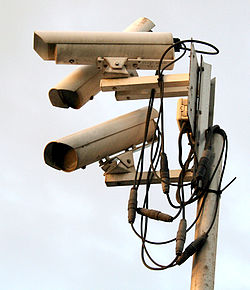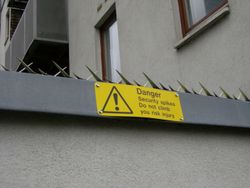Physical security
Physical security describes
, and other systems designed to protect persons and property.Overview
Physical security systems for protected facilities can be intended to:[2][3][4]
- deter potential intruders (e.g. warning signs, security lighting);
- detect intrusions, and identify, monitor and record intruders (e.g. security alarms, access control and CCTV systems);
- trigger appropriate incident responses (e.g. by security guards and police);
- delay or prevent hostile movements (e.g. door reinforcements, grilles);
- protect the assets (e.g. safes).
It is up to security designers, architects and analysts to balance security controls against risks, taking into account the costs of specifying, developing, testing, implementing, using, managing, monitoring and maintaining the controls, along with broader issues such as aesthetics, human rights, health and safety, and societal norms or conventions. Physical access security measures that are appropriate for a high security prison or a military site may be inappropriate in an office, a home or a vehicle, although the principles are similar.
Elements and design
Deterrence
The goal of deterrence methods is to convince potential attackers that a successful attack is unlikely due to strong defenses.
The initial layer of security for a campus, building, office, or other physical space can use crime prevention through environmental design to deter threats. Some of the most common examples are also the most basic: warning signs or window stickers, fences, vehicle barriers, vehicle height-restrictors, restricted access points, security lighting and trenches.[5][6][7][8]
Physical barriers
For example, tall fencing, topped with
Security lighting
Security lighting is another effective form of deterrence. Intruders are less likely to enter well-lit areas for fear of being seen. Doors, gates, and other entrances, in particular, should be well lit to allow close observation of people entering and exiting. When lighting the grounds of a facility, widely distributed low-intensity lighting is generally superior to small patches of high-intensity lighting, because the latter can have a tendency to create blind spots for security personnel and CCTV cameras. It is important to place lighting in a manner that makes it difficult to tamper with (e.g. suspending lights from tall poles), and to ensure that there is a backup power supply so that security lights will not go out if the electricity is cut off.[10] The introduction of low-voltage LED-based lighting products has enabled new security capabilities, such as instant-on or strobing, while substantially reducing electrical consumption.[11]
Security lighting for nuclear power plants in the United States
For
Intrusion detection and electronic surveillance
Alarm systems and sensors
However, alarms are only useful if there is a prompt response when they are triggered. In the reconnaissance phase prior to an actual attack, some intruders will test the response time of security personnel to a deliberately tripped alarm system. By measuring the length of time it takes for a security team to arrive (if they arrive at all), the attacker can determine if an attack could succeed before authorities arrive to neutralize the threat. Loud audible alarms can also act as a psychological deterrent, by notifying intruders that their presence has been detected.[13]
In some U.S. jurisdictions, law enforcement will not respond to alarms from intrusion detection systems unless the activation has been verified by an eyewitness or video.[14] Policies like this one have been created to combat the 94–99 percent rate of false alarm activation in the United States.[15]
Video surveillance

Surveillance cameras can be a deterrent[16] when placed in highly visible locations and are useful for incident assessment and historical analysis. For example, if alarms are being generated and there is a camera in place, security personnel assess the situation via the camera feed. In instances when an attack has already occurred and a camera is in place at the point of attack, the recorded video can be reviewed. Although the term closed-circuit television (CCTV) is common, it is quickly becoming outdated as more video systems lose the closed circuit for signal transmission and are instead transmitting on IP camera networks.
Video monitoring does not necessarily guarantee a human response. A human must be monitoring the situation in real time in order to respond in a timely manner; otherwise, video monitoring is simply a means to gather evidence for later analysis. However, technological advances like
Access control
Mechanical access control systems
Mechanical access control systems include turnstiles, gates, doors, and locks.
Electronic access control systems
Electronic access control systems provide secure access to buildings or facilities by controlling who can enter and exit. Some aspects of these systems can include:
- Access credentials - Access cards, fobs, or badges are used to identify and authenticate authorized users. Information encoded on the credentials is read by card readers at entry points.
- Access control panels - These control the system, make access decisions, and are usually located in a secure area. Access control software runs on the panels and interfaces with card reader.
- Readers - Installed at access points, these read credentials or other data, and send information to the access control panel. Readers can be proximity, magnetic stripe, smart card, biometrics, etc.
- Door locking hardware - Electrified locks, electric strikes, or maglocks physically secure doors and release when valid credentials are presented. Integration allows doors to unlock when authorized.
- Request to exit devices - These allow free egress through an access point without triggering an alarm. Buttons, motion detectors, and other sensors are commonly used.
- Alarms - Unauthorized access attempts or held/forced doors can trigger audible alarms and alerts. Integration with camera systems also occurs.
- Access levels - Software can limit access to specific users, groups, and times. For example, some employees may have 24/7 access to all areas while others are restricted.
- Event logging - Systems record activity like access attempts, alarms, user tracking, etc. for security auditing and troubleshooting purposes.
Electronic access control uses credential readers, advanced software, and electrified locks to provide programmable, secure access management for facilities. Integration of cameras, alarms and other systems is also common.
An additional sub-layer of mechanical/electronic access control protection is reached by integrating a key management system to manage the possession and usage of mechanical keys to locks or property within a building or campus.[citation needed]
Identification systems and access policies
Another form of access control (procedural) includes the use of policies, processes and procedures to manage the ingress into the restricted area. An example of this is the deployment of security personnel conducting checks for authorized entry at predetermined points of entry. This form of access control is usually supplemented by the earlier forms of access control (i.e. mechanical and electronic access control), or simple devices such as physical passes.
Security personnel

Security personnel play a central role in all layers of security. All of the technological systems that are employed to enhance physical security are useless without a security force that is trained in their use and maintenance, and which knows how to properly respond to breaches in security. Security personnel perform many functions: patrolling facilities, administering electronic access control, responding to alarms, and monitoring and analyzing video footage.[23]
See also
- Alarm management
- Artificial intelligence for video surveillance
- Biometric device
- Biometrics
- Computer security
- Door security
- Executive protection
- Guard tour patrol system
- Information security
- Infrastructure security
- Logical security
- Nuclear security
- Perimeter intrusion detection system
- Physical Security Professional
- Security alarm
- Security company
- Security convergence
- Security engineering
- Surveillance
- High-voltage transformer fire barriers
References
- ^ "Chapter 1: Physical Security Challenges". Field Manual 3-19.30: Physical Security. Headquarters, United States Department of Army. 2001. Archived from the original on 2013-03-13.
- ISBN 9780080554280. Archivedfrom the original on 2013-09-21.
- ^ "Chapter 2: The Systems Approach". Field Manual 3-19.30: Physical Security. Headquarters, United States Department of Army. 2001. Archived from the original on 2013-09-21.
- ISBN 978-0-471-38922-4.
- ISBN 9780124158924. Archivedfrom the original on 2018-01-05.
- ISBN 978-0-7844-0457-7. Archivedfrom the original on 2018-01-05.
- ISBN 9781420099638. Archivedfrom the original on 2018-01-05.
- ^ "Chapter 4: Protective Barriers". Field Manual 3-19.30: Physical Security. Headquarters, United States Department of Army. 2001. Archived from the original on 2013-03-13.
- ISBN 9781118211267. Archivedfrom the original on 2018-01-05.
- ISBN 9780750674874. Archivedfrom the original on 2018-01-05.
- ^ "Use of LED Lighting for Security Purposes". silvaconsultants.com. Retrieved 2020-10-06.
- ^ "Chapter 6: Electronic Security Systems". Field Manual 3-19.30: Physical Security. Headquarters, United States Department of Army. 2001. Archived from the original on 2013-03-13.
- ISBN 9780124158924. Archivedfrom the original on 2013-09-21.
- ^ "Evaluation of alternative policies to combat false emergency calls" (PDF). p. 238. Archived from the original (PDF) on 2012-11-01.
- ^ "Evaluation of alternative policies to combat false emergency calls" (PDF). p. 233. Archived from the original (PDF) on 2012-11-01.
- ^ "Evaluating the Use of Public Surveillance Cameras for Crime Control and Prevention" (PDF). Archived (PDF) from the original on 2012-12-01.
- ISBN 9780080558783. Archivedfrom the original on 2018-01-05.
- ISBN 9781118577868. Archivedfrom the original on 2018-01-05.
- ISBN 9780080961699. Archivedfrom the original on 2013-09-29.
- ISBN 9780750672559. Archivedfrom the original on 2018-01-05.
- ^ "Chapter 7: Access Control". Field Manual 3-19.30: Physical Security. Headquarters, United States Department of Army. 2001. Archived from the original on 2007-05-10.
- ISBN 9780080494708. Archivedfrom the original on 2018-01-05.
- ISBN 9780881734836. Archivedfrom the original on 2018-01-05.





